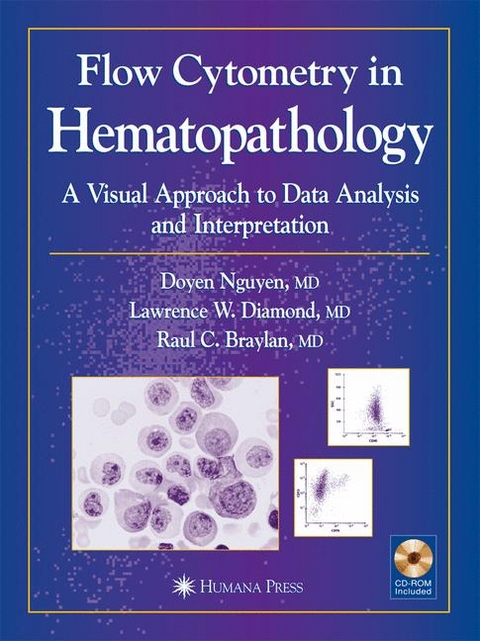
Flow Cytometry in Hematopathology
Humana Press Inc. (Verlag)
978-1-58829-212-4 (ISBN)
- Titel erscheint in neuer Auflage
- Artikel merken
This unique text offers a systematic and practical approach to the analysis and interpretation of FCM graphics. Using numerous FCM illustrations derived from actual well-documented clinical cases, the authors demonstrate a step-by-step approach to optimal FCM data analysis on specimens suspected of harboring hematopoietic malignancies. The discussion moves from simple to complex specimens, with an emphasis on visual pattern analysis. A wide variety of hematologic disorders are covered, including leukemias and lymphomas. The companion CD-ROM with 80 detailed case studies provides additional opportunities to gain a deeper understanding of FCM data analysis.
Chapter 1. Approach to Flow Cytometry: General Considerations1.1 Reasons for the necessity of proper data analysisThe pitfalls of the FCM data format of "percent positive" per antibody tested.1.2 General aspects of FCM data analysis and interpretation1.3 Other applications of FCM in hematopathology1.4 Overview of lineage-associated markersChapter 2. FCM Immunophenotyping and DNA Analysis: Practical Aspects That Can Affect Data Analysis and Interpretation2.1 Sample selectionLiquid specimensSolid tissue specimens2.2 Preparing nucleated cell suspensions2.3 Cell yield and viability2.4 Sample stainingSurface antigensIntracellular antigensDNA content2.5 Data acquisitionCalibrationColor compensationList mode data collectionExclusion of nonviable cells2.6 Antibody panel designAntibody selectionAnti-light chain antibodiesFluorochrome conjugation2.7 Comprehensive antibody panelsDisease-oriented antibody panelsAntibody panels oriented by specimen type2.8 Tailored panels and add-on testingMinimal residual disease2.9 FCM immunophenotyping data representationAnalysis panelsColor display2.10 Approach to DNA data analysisDNA ploidyS-phaseChapter 3. FCM Data Analysis on Nearly Homogeneous Samples3.1 FCM parametersForward scatterSide scatterFluorescenceHeterogeneous fluorescence intensity (bimodal, variable)3.2 Fluorescence dynamic range3.3 Strategy to the visual review of FCM immunophenotyping data3.4 Common SSC/CD45 patternsAssessment of the blast populationImmature neoplastic cells with downregulated CD45SSC/CD45 in mature lymphoid disorders3.5 Other dot plot patterns useful in acute leukemia diagnosisUseful antigenic features in AMLMyeloid phenotypic abnormalities and MRD detectionPrecursor B-ALL vs bone marrow precursor B-cells (hematogones)3.6 Evaluation of mature lymphoid malignanciesAssessment of surface light chain expressionAssessment of pan B-cell antigensUseful antigenic features in mature B-cell malignanciesCD10 expression: Follicular center cell lymphomasPattern of CD20 and CD11c coexpressionCD5 expressionAberrant B-cell profileIdentification of abnormal T-cellsUseful antigenic features in mature T-cell malignancies3.7 Dot plot patterns in histiocytic proliferations and nonhematopoietic malignanciesChapter 4. FCM data analysis on heterogeneous specimens4.1 Identifying normal FCM samplesBenign/reactive solid lymphoid tissue (e.g., lymph nodes, tonsils)Pattern of CD10/CD20 coexpression. Distinction between FRFH and FCC lymphomaNormal peripheral blood and normal bone marrowBlast regionBone marrow B-cell precursors (hematogones)LymphocytesMonocytesPlasma cellsErythroid precursorsMaturing myeloid cells4.2 Abnormal samples with a detectable immature neoplastic populationBlasts of lymphoid lineageBlasts of myeloid lineageAMLHigh-grade MDS and MPD with increased blasts4.3 Minimal residual disease4.4 Abnormal samples with detectable mature neoplastic populationsAbnormal mature B-cells. Evaluation of CD5 and CD23FCM features suggestive of anti-CD20 therapyAbnormal mature T-cells. Abnormal plasma cells present4.5 Abnormal blood or bone marrow samples with no detectable neoplastic cellsAltered cellular composition and abnormal SSCAbnormal antigenic maturation in myeloid or erythroid precursors4.6 Coexisting malignanciesChapter 5 FCM interpretation and reporting5.1 Immature hematopoietic malignanciesALL/lymphoblastic lymphomaMyeloid malignanciesAML-M3AML with minimal maturationAML with maturationAML with monocytic differentiationAML with erythroid hyperplasiaAML with megakaryocytic differentiationMPD and MDSAcute leukemias with a multilineage antigenic profile5.2 Mature lymphoid malignanciesB-cell LPD/NHL. CD10 expressionCoexpression of CD11c, CD25, and CD103Coexpression of CD5 and CD23. CD5+CD23 B-cell neoplasmsCD45 and/or pan B-cell antigens markedly downregulatedNondescript B-cell phenotype and high FSCNondescript B-cell phenotype and low FSCMonoclonal B-cells of undetermined significancePlasma cell dyscrasiasT-cell LPD/NHLCD4+ T-cell LPD/NHL. CD8+ disordersCD30+ lymphoma5.3 FCM reportingSuggested ReadingAppendixIndex
| Erscheint lt. Verlag | 1.12.2002 |
|---|---|
| Reihe/Serie | Current Clinical Pathology |
| Verlagsort | Totowa, NJ |
| Sprache | englisch |
| Maße | 216 x 280 mm |
| Themenwelt | Medizinische Fachgebiete ► Innere Medizin ► Hämatologie |
| Medizin / Pharmazie ► Medizinische Fachgebiete ► Onkologie | |
| Studium ► 2. Studienabschnitt (Klinik) ► Anamnese / Körperliche Untersuchung | |
| ISBN-10 | 1-58829-212-6 / 1588292126 |
| ISBN-13 | 978-1-58829-212-4 / 9781588292124 |
| Zustand | Neuware |
| Haben Sie eine Frage zum Produkt? |
aus dem Bereich


